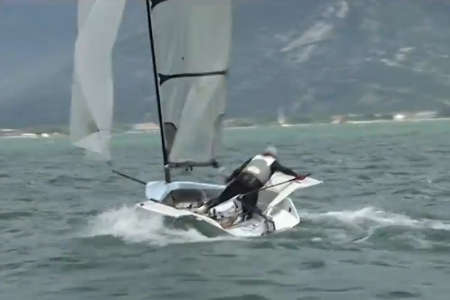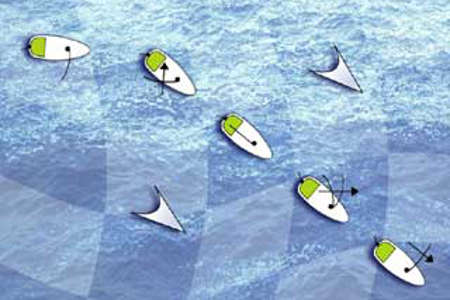Jibing is a basic maneuver in steering a sailboat. It is particularly well-known for being potentially dangerous.
Everything will go smoothly as long as you keep an eye on the boom and the wind direction, which already requires some experience.
To avoid unpleasant surprises, you must get your bearings and develop a minimum sense of the wind and the boat. This is what is called seamanship, which can only be acquired through practice...
Fairly easy to perform in medium to moderate winds, jibing becomes difficult to control in strong winds. It is therefore not recommended under such conditions, even for an experienced crew.
Definition
A jibe involves switching from one tack to the other with the wind at your back.
The sails will therefore change sides, just like in a tack.


During a jibe, the wind catches the mainsail from behind, causing it to swing from one side of the boat to the other. If the sail is not centered along the boat's axis when the helmsman turns the boat through the wind, the mainsail will sweep violently across the deck. The boom (the horizontal spar supporting the mainsail) becomes a hazard for anything in its path, especially heads.
If the maneuver is anticipated and controlled, there’s no cause for concern. The danger arises when the helmsman loses control of the boat’s trajectory and the crew is unaware of the risk of an involuntary jibe, known as a "wild jibe." This poses a real threat. Material damage can be significant, ranging from a broken boom to dismasting.
Human injuries can range from minor bruises to severe head trauma. The risk of a crew member going overboard with loss of consciousness becomes significant...
NB
It is recommended that less experienced crews avoid jibing in winds stronger than Force 4.
No crew member or passenger should be in the boom's path: no one should stand on the deck, behind the shrouds, or in the cockpit.
Those not involved in the maneuver should position themselves at the stern or inside the boat.
No one should sit near the mainsheet traveler.
Ideally, crew members should remain seated in the cockpit during the maneuver.
All crew members should monitor the boom's movement throughout the maneuver.
It is recommended that the mainsail trimmer wear gloves.
-Check that the mainsail and genoa sheets are coiled and ready to run freely.
-Position a crew member at the mainsail sheet and at each genoa winch, depending on the number of crew members available.
-The helmsman brings the boat to a broad reach, with the wind vane pointing about a quarter towards the stern. Avoid zigzagging!
NB: If the clew of the genoa collapses, it's a sign that you're approaching dead downwind because the mainsail is blanketing the genoa. A small adjustment to the helm (in the correct direction!) will return the boat to a broad reach and avoid an uncontrolled jibe.
-The helmsman announces the maneuver clearly to the crew by asking, “Ready to jibe?”
-The mainsail trimmer locks the traveler “in the middle” (aligned with the boat’s axis).
-They then trim the mainsheet to bring the boom as close to the boat’s centerline as possible.
NB: If trimming the sheet is too difficult, ask for assistance from another crew member.
-The genoa trimmer begins to release the leeward sheet, keeping it under tension with two turns on the winch.
-Another crew member wraps two clockwise turns on the windward genoa winch.
NB: All crew members must now be seated in the cockpit for the maneuver. No one should be in the boom’s path.
-The crew members are now ready to maneuver. Each of them announces it clearly to the helmsman by responding, “Ready!”
Jibing is a basic maneuver in steering a sailboat. It is particularly well-known for being potentially dangerous.
Everything will go smoothly as long as you keep an eye on the boom and the wind direction, which already requires some experience.
To avoid unpleasant surprises, you must get your bearings and develop a minimum sense of the wind and the boat. This is what is called seamanship, which can only be acquired through practice...
Fairly easy to perform in medium to moderate winds, jibing becomes difficult to control in strong winds. It is therefore not recommended under such conditions, even for an experienced crew.
Definition
A jibe involves switching from one tack to the other with the wind at your back.
The sails will therefore change sides, just like in a tack.


During a jibe, the wind catches the mainsail from behind, causing it to swing from one side of the boat to the other. If the sail is not centered along the boat's axis when the helmsman turns the boat through the wind, the mainsail will sweep violently across the deck. The boom (the horizontal spar supporting the mainsail) becomes a hazard for anything in its path, especially heads.
If the maneuver is anticipated and controlled, there’s no cause for concern. The danger arises when the helmsman loses control of the boat’s trajectory and the crew is unaware of the risk of an involuntary jibe, known as a "wild jibe." This poses a real threat. Material damage can be significant, ranging from a broken boom to dismasting.
Human injuries can range from minor bruises to severe head trauma. The risk of a crew member going overboard with loss of consciousness becomes significant...
NB
It is recommended that less experienced crews avoid jibing in winds stronger than Force 4.
No crew member or passenger should be in the boom's path: no one should stand on the deck, behind the shrouds, or in the cockpit.
Those not involved in the maneuver should position themselves at the stern or inside the boat.
No one should sit near the mainsheet traveler.
Ideally, crew members should remain seated in the cockpit during the maneuver.
All crew members should monitor the boom's movement throughout the maneuver.
It is recommended that the mainsail trimmer wear gloves.
-Check that the mainsail and genoa sheets are coiled and ready to run freely.
-Position a crew member at the mainsail sheet and at each genoa winch, depending on the number of crew members available.
-The helmsman brings the boat to a broad reach, with the wind vane pointing about a quarter towards the stern. Avoid zigzagging!
NB: If the clew of the genoa collapses, it's a sign that you're approaching dead downwind because the mainsail is blanketing the genoa. A small adjustment to the helm (in the correct direction!) will return the boat to a broad reach and avoid an uncontrolled jibe.
-The helmsman announces the maneuver clearly to the crew by asking, “Ready to jibe?”
-The mainsail trimmer locks the traveler “in the middle” (aligned with the boat’s axis).
-They then trim the mainsheet to bring the boom as close to the boat’s centerline as possible.
NB: If trimming the sheet is too difficult, ask for assistance from another crew member.
-The genoa trimmer begins to release the leeward sheet, keeping it under tension with two turns on the winch.
-Another crew member wraps two clockwise turns on the windward genoa winch.
NB: All crew members must now be seated in the cockpit for the maneuver. No one should be in the boom’s path.
-The crew members are now ready to maneuver. Each of them announces it clearly to the helmsman by responding, “Ready!”